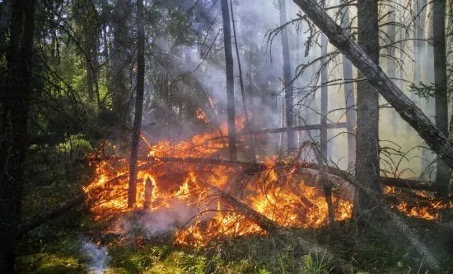According to a recently published study in the journal Science, the World’s forests cannot alone solve the climate crisis despite the potential to store more carbon. The scientific report has been conducted by Zürich Technical University, ETH, with support from the EU Commission’s Joint Research Centre, JRC.
This is a translation of an article from iSkogen.se signed Fredrik Reuter.
The forest is not enough
The study is hypothetic, conducted by using AI, and based on data like the EU’s satellite data from Copernicus and Globiomass. It shows a scenario where we stop managing the World’s forests.
However, there is a large limitation as the study only looks at carbon storage above ground, meaning growing biomass in vegetation that we can see. The carbon storage in the ground, roots, etc., is not included in the study which is a pity. It would probably take another comprehensive study to look at that.
Less climate effect than previously estimated
The result of the study shows less climate effect than earlier research has shown. The hypothesis, if it’s correct, shows that the World’s forests alone cannot handle climate change. If we stop managing all forests, the carbon storage would increase by 15 – 16 percent which corresponds to approx. 44 billion tons of coal or approx. 162 billion tons of carbon dioxide.
The authors of the study claim that this corresponds to 4 years of 2019’s total carbon dioxide emissions. It means that an adjustment to maximum carbon storage would make us climate neutral for four years, with 2019 as the referent. Nothing to brag about(?). 
Different carbon storage in different parts of the World
The study shows that the moist tropics and tempered zones can hold the highest biomass values, approx. 600 tons per hectare. The boreal forests that cover vast areas of the Nordic Countries, Russia, and Canada, were shown to have a significantly lower potential and reach only 150 tons of biomass per hectare.
An interesting detail in the study was that cases of negative carbon storage were found in some boreal regions. This occurred when well-managed forests were compared to natural ones. The researchers believe that facts like that the most fertile soils are used for forest plantation, and efficient firefighting could explain this.
Climate crisis, AI, and satellites … yet again
In the summer of 2020, a JRC report was released by Nature using AI and satellite data and concluded that a vast increase in felling had occurred in Europe. This report needs no further introduction as it’s still being discussed today. But now it happens again, and parts of the data used in 2020 are used also this time. There are many similarities, e.g., that JRC is also backing this study.
A significant difference is that those who were the most dissatisfied in 2020 are the most satisfied in 2023. The reason for this is probably that the 2023 hypothesis shows that we cannot save the earth by leaving the forest without management. In other words – we can keep on using and managing it.
Like in many other studies, there are uncertainties. One example is how data is processed. In this study, the researchers seem to have used a relatively high-resolution data set and then scaled it up to pixels of 10 x 10 kilometers. One uncertainty seems to be that there isn’t enough primary forest or “intact forest”. Something that the researcher refers to as an “uncertain factor”. And during a risk analysis it turned out that if a reasonable share of primary forest that was not in the data set, was added by the researchers, the carbon storage increased by 36 percent. 
How do we fight the climate change in the forest?
The study that is now published by Science makes an approach that could be important for the future. However, the most important to fight climate change is to reduce carbon emissions.
But the report is quite stiff-legged with theories about how monocultures can generate high wood storage – in Sweden we learned what monocultures can do during the “summer of wildfires” in 2018. There is also a thesis in the study to stop all human activity in the forest. A utopia that only academics could have.
Furthermore, it would have been interesting to see a scenario where you try to maximize carbon storage through human impact. Keeping high wood storage and vital forests and creating as long-lived products as possible from the forest. How that would affect the result of the study we will never find out(?).













